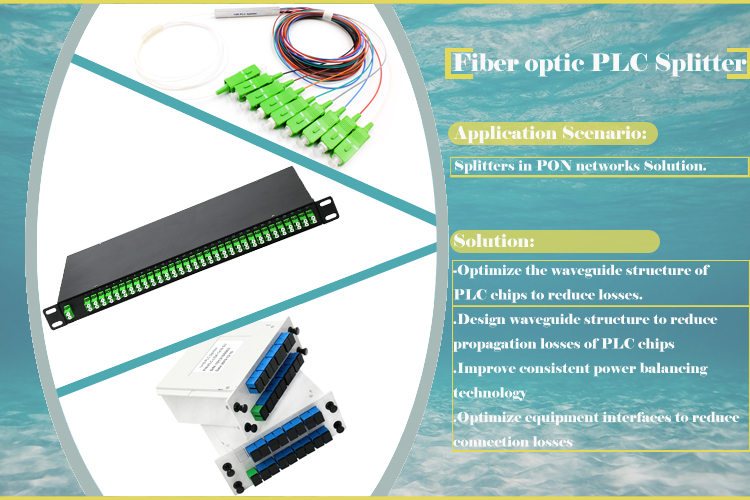Enhancing PON Networks
with Fiber Optic PLC Splitters:Optimizing Waveguide Structures and Power Balancing
Introduction
As the demand for high-speed and efficient broadband services continues to rise, Passive Optical Network (PON) networks have become a popular choice for delivering reliable internet connectivity. Within these networks, Fiber Optic PLC (Planar Lightwave Circuit) splitters play a crucial role in distributing optical signals to multiple subscribers. To ensure optimal performance and minimize signal losses, it is imperative to focus on enhancing the waveguide structure of PLC chips, implementing consistent power balancing technology, and optimizing equipment interfaces to reduce connection losses. In this article, we will delve into these application scenarios and explore the solutions that enable the seamless integration of Fiber Optic PLC splitter in PON networks.

Optimizing Waveguide Structure for Reduced Propagation Losses
One of the key challenges in PON networks is minimizing signal losses as the optical signals traverse through the various components. In the case of Fiber Optic PLC splitters, the waveguide structure of the chips plays a critical role in determining the efficiency of signal distribution. By carefully designing the waveguide structure, it is possible to reduce propagation losses and ensure that the optical signals reach their intended destinations with minimal degradation. Manufacturers are investing in research and development to enhance the waveguide structure, utilizing advanced materials and fabrication techniques to achieve superior performance.
Implementing Consistent Power Balancing Technology
Maintaining consistent power levels across the output ports of PLC splitters is crucial for efficient signal distribution in PON networks. Power imbalances can lead to degraded performance and signal quality issues for end-users. To address this challenge, industry-leading PLC splitter manufacturers have developed innovative power balancing technologies. These technologies ensure that the optical power is evenly distributed among the output ports, allowing for reliable and consistent signal transmission. By implementing these power balancing techniques, PON network operators can optimize the performance of their networks and deliver a seamless user experience.
Optimizing Equipment Interfaces to Reduce Connection Losses
In any optical network, it is essential to minimize connection losses to ensure the efficient transmission of signals. When it comes to PLC splitters, optimizing the interfaces between the splitters and other network equipment is imperative. By employing precision manufacturing techniques and high-quality connectors, the connection losses can be significantly reduced. These optimizations ensure that the optical signals pass through the network components with minimal attenuation, resulting in improved overall network performance.
Conclusion
Fiber Optic PLC splitters are vital components in PON networks, facilitating the distribution of optical signals to multiple subscribers. To enhance the performance of these networks, it is essential to focus on optimizing the waveguide structure of PLC chips, implementing consistent power balancing technology, and optimizing equipment interfaces to reduce connection losses. By investing in research and development, manufacturers are continuously improving the design and functionality of PLC splitters, enabling network operators to deliver high-speed and reliable broadband services to their customers. As the demand for faster and more efficient connectivity continues to grow, the advancements in PLC splitter technology will play a crucial role in shaping the future of PON networks.
Keywords:Fiber optic PLC splitter, PON networks, Waveguide structure, Propagation losses, Power balancing technology, Connection losses, Optical signals, Signal distribution, Network performance, Broadband services
FAQs
Q1.What is power balancing technology, and why is it crucial in PON networks?
Power balancing technology ensures consistent power levels across the output ports of a PLC splitter. It is crucial in PON networks to maintain equal power distribution among the subscribers to avoid signal quality issues and ensure reliable performance for all end-users.
Q2.How can power imbalances impact signal quality in a PON network?
Power imbalances in a PON network can result in uneven signal distribution, leading to degraded performance and signal quality issues for end-users. It can cause variations in data transmission rates and affect the overall network efficiency.
Q3.How do advancements in PLC splitter technology shape the future of PON networks?
Advancements in PLC splitter technology are instrumental in shaping the future of PON networks. Ongoing research and development efforts lead to improved waveguide structures, power balancing techniques, and optimized interfaces. These advancements enable network operators to deliver faster and more efficient broadband services, meeting the ever-growing demand for reliable connectivity.
Q4.How can equipment interfaces be optimized to minimize connection losses?
Optimizing equipment interfaces involves using precision manufacturing techniques and high-quality connectors. By ensuring proper alignment and reducing signal attenuation at the connection points, the losses can be minimized, resulting in improved signal transmission and network performance.
Q5.What are the benefits of investing in high-quality connectors for PLC splitters?
Investing in high-quality connectors for PLC splitters ensures reliable and secure connections. These connectors provide better signal integrity, reduced insertion losses, and improved durability, resulting in enhanced overall network performance and longevity.

 The Future of Fiber Optic Communication Network Architecture: Evolution and the Role of SDON Technology
The Future of Fiber Optic Communication Network Architecture: Evolution and the Role of SDON Technology
 What opportunities and challenges does free-space optical communication technology face?
What opportunities and challenges does free-space optical communication technology face?
 Opelink MPO Products for High-Speed Data Center Applications
Opelink MPO Products for High-Speed Data Center Applications
 CWDM vs. DWDM: Which Optical Transmission Technology Should You Choose?
CWDM vs. DWDM: Which Optical Transmission Technology Should You Choose?